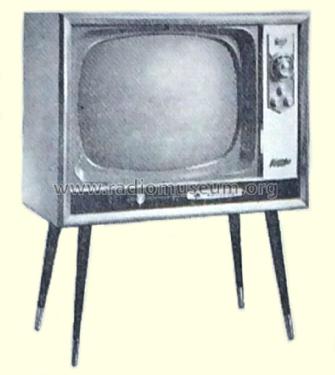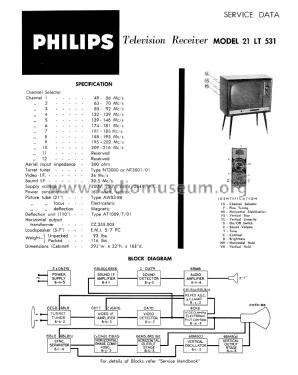21LT531
Philips Australia
- Country
- Australia
- Manufacturer / Brand
- Philips Australia
- Year
- 1959/1960
- Category
- Television Receiver (TV) or Monitor
- Radiomuseum.org ID
- 216138
Click on the schematic thumbnail to request the schematic as a free document.
- Number of Tubes
- 17
- Valves / Tubes
- 6ES8 6BL8 6BY7 6BX6 6BX6 6CK6 6BL8 6BX6 6BM8 6BL8 6BL8 6BM8 6BX6 6CM5 6R3 1S2 AW53-88
- Number of Transistors
- Main principle
- Superhet with RF-stage; ZF/IF 36000/30500 kHz; 2 AF stage(s)
- Wave bands
- VHF incl. FM and/or UHF (see notes for details)
- Power type and voltage
- Alternating Current supply (AC) / 200; 220; 240; 254 Volt
- Loudspeaker
- Permanent Magnet Dynamic (PDyn) Loudspeaker (moving coil) - elliptical
- Material
- Wooden case
- from Radiomuseum.org
- Model: 21LT531 - Philips Australia
- Shape
- Console, Lowboy (legs < 50 %).
- Dimensions (WHD)
- 29.25 x 22 x 16.75 inch / 743 x 559 x 425 mm
- Notes
-
Philips 531
A 21" lowboy TV receiver has a 110º aluminised electrostatic-focus tube, 16 valves, six germanium, and two silicon diodes. Cabinet finish: maple, walnut, or rose mahogany. Features: aerial input 75 or 300 ohms. Ten-channel cascade turret tuner. Three high-gain wide-band vision IF stages. DC coupled to picture tube; beam current is limited to protect picture tube. Two-stage sound IF with envelope feedback. Ratio detector; audio amplifier with inverse feedback. Tuner clamped; keyed AGC; balanced line hold; stabilised width and EHT. "Magic-eye" photocell for automatic contrast/brightness. Front-mounted speaker 7" x 5". Controls: front-mounted - push-button on-off (includes spot-killer); illuminated channel selector/fine-tuning; concentric tone/volume; contrast/brightness; horizontal hold/vertical hold. (FROM MINGAY'S PRICE SERVICE)
53 cm television set tunes the 10 then standard Australian VHF channels. Cabinet finishes are available in Maple walnut & Rose Mahogany.
- Net weight (2.2 lb = 1 kg)
- 93 lb (93 lb 0 oz) / 42.222 kg
- Price in first year of sale
- 194.25 AUS £
- Mentioned in
- Mingay's Price Service (Feb 1960.)
- Literature/Schematics (1)
- -- Original-techn. papers. (Philips Service Data)
- Literature/Schematics (2)
- J.R. Publications Television Service Handbook (L.J. Series Vol. 1, 1962 & Vol. 2, 1967, Page P11.)
- Author
- Model page created by Stuart Irwin. See "Data change" for further contributors.
- Other Models
-
Here you find 916 models, 716 with images and 425 with schematics for wireless sets etc. In French: TSF for Télégraphie sans fil.
All listed radios etc. from Philips Australia



